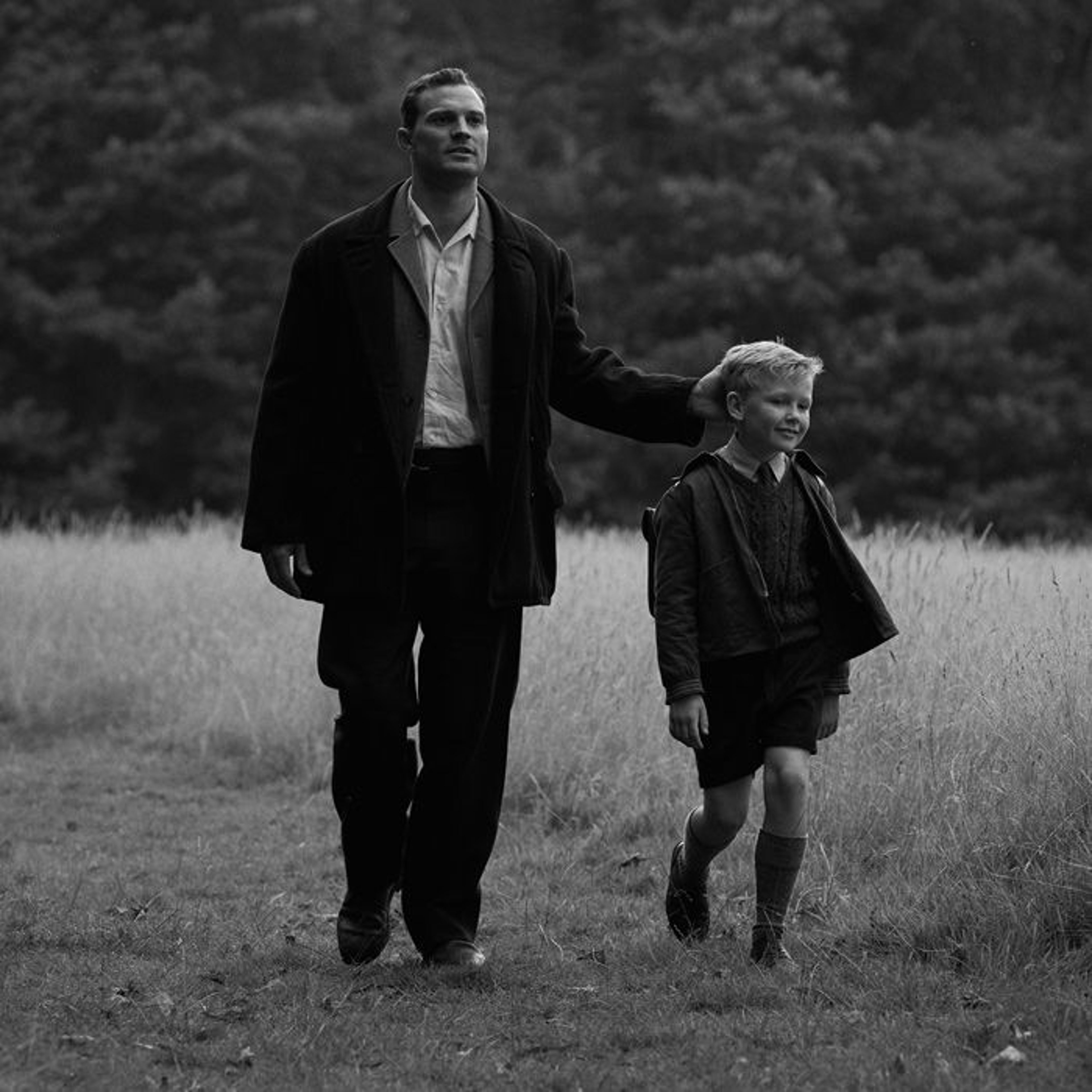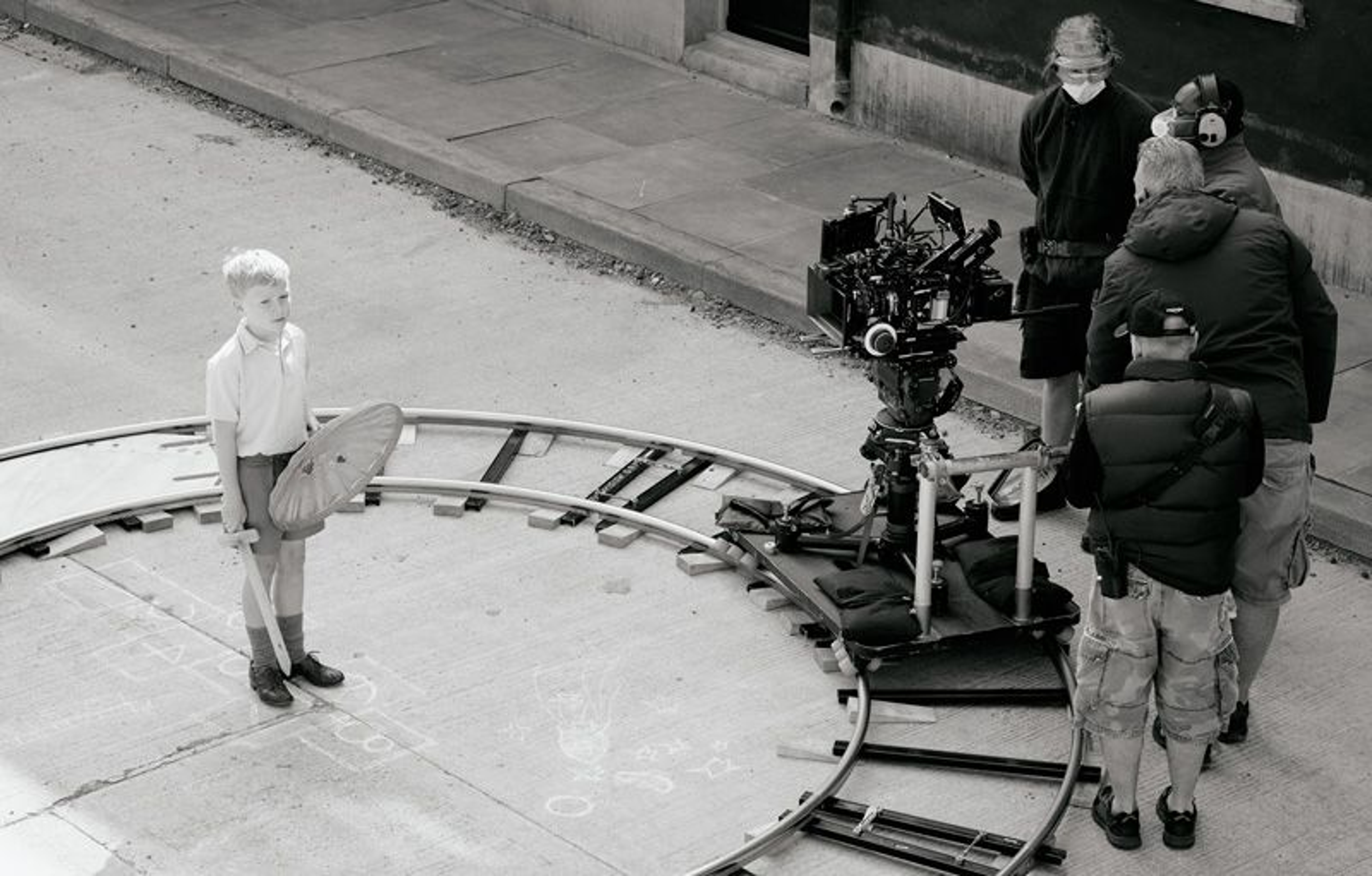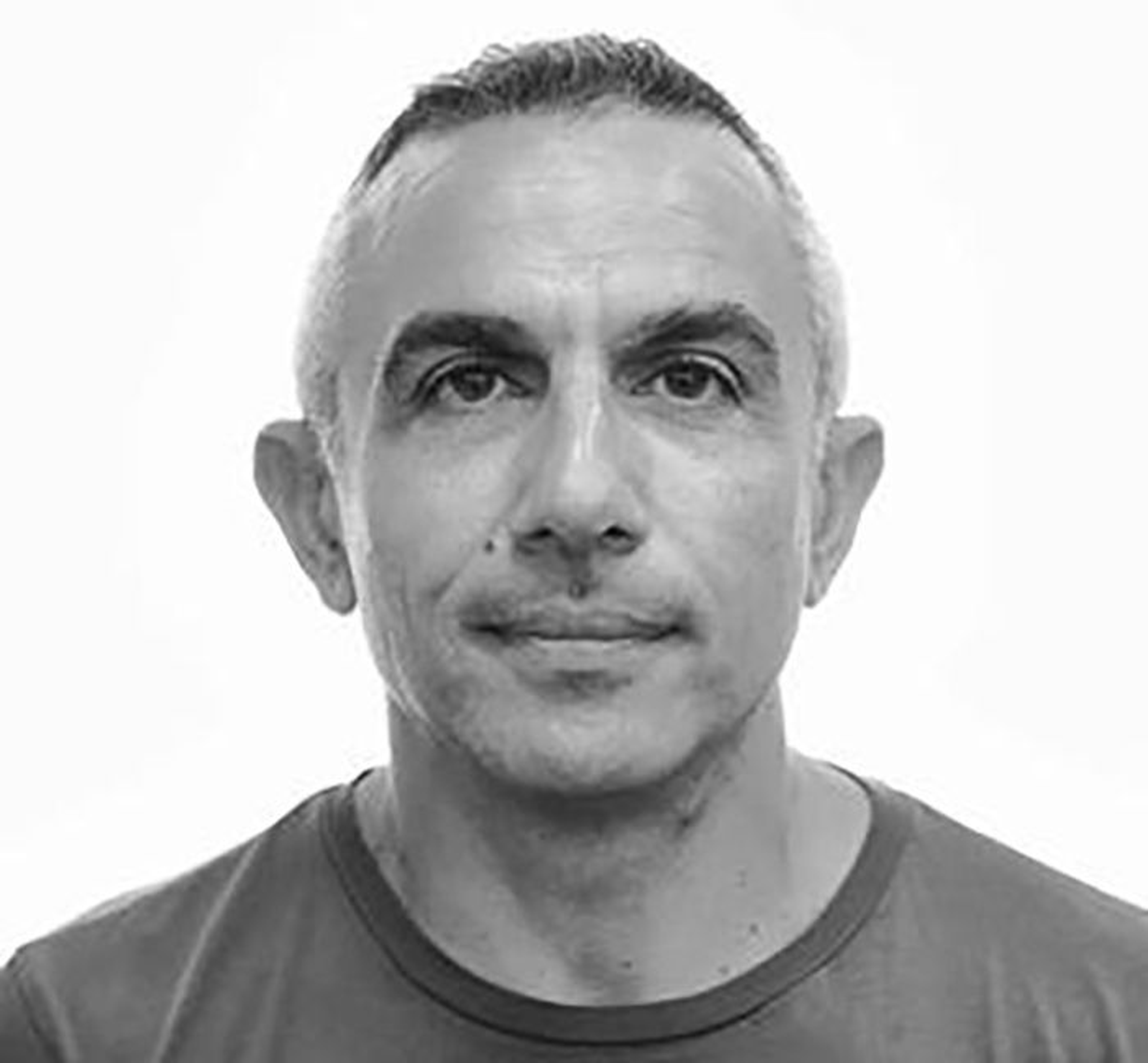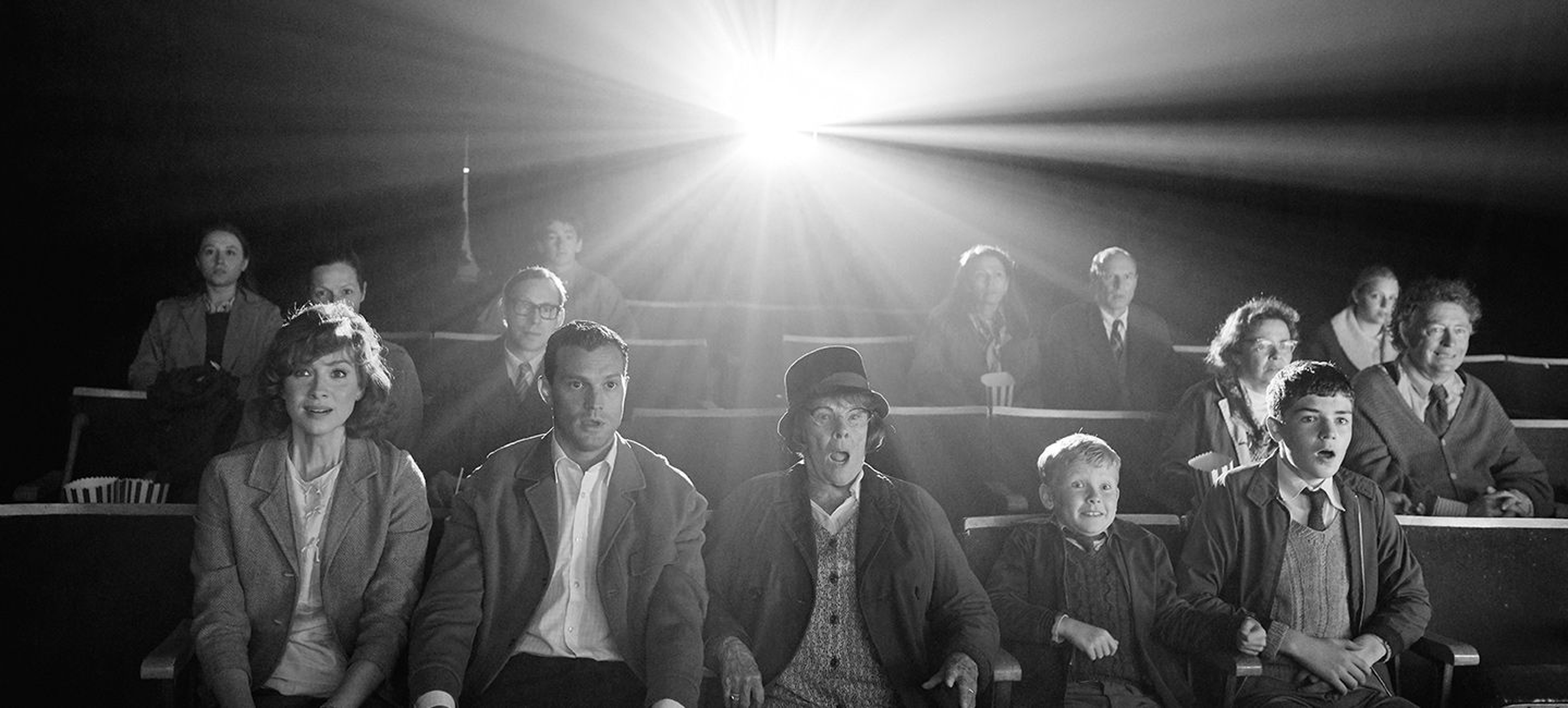In Belfast, writer/director Kenneth Branagh returns to his childhood and the poetic perspective of a young boy coming to understand the beauty and challenges all around him. For nine-year-old Buddy (Jude Hill), the world is filled with the adventure of Hollywood movies, a budding romance with a girl at school, the warmth of his grandparents (Judi Dench and Ciarán Hinds), and the guidance of his Ma (Caitríona Balfe) and Pa (Jamie Dornan). When the political tension that became known as The Troubles erupts on his street, his entire world begins to change. To capture the high drama and tender beauty of Buddy’s world, Branagh worked with his long-time cinematographer, Haris Zambarloukos, to shoot the film in “Hollywood black and white,” a style which according to the director can make “even the most prosaic of environments feel glamorous or epic.”
Zambarloukos, who’d previously worked with Branagh on movies as imaginative and different as Murder on the Orient Express, Cinderella, and Thor, knew exactly how to frame this story to keep its stark reality within the enthusiastic memories of an irresistible boy. For audiences and critics, the film’s look has been nothing short of magical. Variety writes, “The visually stunning, heartwarming film shot by Haris Zambarloukos is so deliciously rich that this film could walk home with a few statues come 2022.” And Zambarloukos has already been nominated for Best Cinematography by the British Independent Film Awards.
We spoke with Zambarloukos about connecting to the film’s sincerity, discovering emotional color in black and white, and finding his own personal story told in the film.
Belfast is now on demand and playing in theaters.
The official trailer for Belfast.
When Kenneth Branagh first showed you the script, how did you envision shooting Belfast?
I discover a film through the process of reading the script and talking to the director. For Belfast, the process of discovery was a really pleasurable one. There were lots of intimate talks with Ken about what the film might look like. A core group of people close to Ken — production designer Jim Clay, First AD Martin Curry, co-producer Celia Duval, and I — spent a weekend with Ken walking around Belfast, retracing many of the areas that he grew up in. Discovering an aspect of his childhood brought out memories of our own childhood and the common ground we shared. We all come from very different parts of the world and are of different ages, which made the story of Belfast all the more universal. What rang true was not that it was a similar story, but that it was told with such sincerity. I think Ken’s sincerity opened us up to find the sincerity in our own work and departments.
Was it intended to be black and white from the start?
No, but we made that decision very early in the process of discovering the film. After reading the script I asked Ken, “Do you think we should shoot this in black and white?" Ken immediately responded, “I knew you were going to ask that."
Branagh talks of it being shot in “Hollywood black and white.” What does that mean and how do you accomplish it?
That was also part of the process. We started off talking about a different type of black and white and ended up with “Hollywood black and white,” which basically refers to the level of contrast. In classic films, like Franks Capra’s movies, there is a much higher key black and white look as opposed to an Italian neorealism movie like The Bicycle Thief or photojournalistic approach like the images in Life Magazine. You can look at the work of Philip Jones Griffiths, a Welsh photographer who took amazing photographs of that period in Northern Ireland to see a different black and white. We started off with the dailies being much softer and we kept going for more contrast. By the end, we were going for the full contrast look.
The movie directly references many Hollywood films. Were there particular movies that influenced the look of Belfast?
There were a combination of films, some which were about childhood and some we looked at for other reasons. The Bicycle Thief was a huge reference, but more contemporary films, like Pawe? Pawlikowski’s Ida, inspired us too. Even though Ida was also in black and white, it was done in very low contrast. There were other references which had more to do with the theme of intimacy than the use of black and white. For example, we used a very Hollywood approach in terms of eyeline. We would often have a very close eyeline so that audiences could feel more engaged with a conversation, or we would have a direct profile. Both choices are very bold and direct and very clear in their thought.

Pa (Jamie Dornan) and Buddy (Jude Hill) in Belfast.
In terms of photography, what photographers inspired you?
Clearly Philip Jones Griffiths. He had the most direct access to Northern Ireland at the time. Although my favorite image of his is not from Northern Ireland, but from Wales. It’s an image of a boy on a broken grand piano in a field near an abandoned coal mine. We wanted to make that same juxtaposition between something artful and in conflict. One of the things Griffiths showed us was how everyday life continues in the midst of civil strife. He has a wonderful shot of a soldier crouching for combat with a woman mowing the lawn behind him. He captured something about the participation in life during troubled times. It's an issue that I am personally aware of being a Greek Cypriot. My own homeland, Cyprus, has been invaded so Belfast’s story of living in a divided world of conflict was very personal and sincere to me. I feel my experience trickled down into the film. It certainly trickled down into my conversations with Ken. I certainly knew what it was like to be a child with a military presence you saw all the time.
In shooting in black and white, how did you coordinate with other departments in terms of getting the color palette right?
I worked a lot with production and costume design. I have worked so much with Jim Clay, the production designer, that I can't imagine my photography without Jim's production design. It was the first time I'd worked with Charlotte Walter and it was equally pleasurable. One of the things we had focused on was texture rather than color. And we consider how to control our tones. With black and white, I always shoot with color capture to control the tonal and textual aspects. If I shoot in color, I can manipulate the levels of grey. A light blue shirt I can make a darker or lighter grey. I will not have that control if the image is captured in black and white. With color, we could create a rich texture, which was not just dependent on the patterns in the cloth or the patina in the wool. If a color was too close to another area of grey, I could take that up or down, giving us a much richer black and white. I was aided immensely by Jim and Charlotte in that they gave me those colors to turn into levels of grey for a more lustrous black and white.
At one level, the movie is about Buddy and his family, and then in a larger frame, it captures what is happening in Northern Ireland. How did you incorporate those stories in your framing?
In the film, we wanted the frame to let the actions speak for themselves. I moved the camera very little, but we were very specific in the framing. We left lots of area in the background for things to happen. The actors could play out a scene with a soldier occasionally crossing the back of the frame. We didn’t want too much of a soldier’s presence in the frame, and we never wanted to cut to one. You see them but it's quite subtle. We would shoot the family through the window, and behind them in the alley, you might have a soldier cross through. Their presence just plays in your mind. I would check in with Ken with each shot how much he wanted or didn’t want their presence. In one scene, there was neighbor party on the street. After it was over, Ken suggested that we let the soldiers help the family move the sofa back inside the house. That was how we showed the way civilian life and military life were mixed together.
What do you feel was unique about the cinematography in the film?
I feel that it is not the cinematography but the story that is unique. The story is so intimate and truthful.

Setting up a track to capture Buddy's (Jude Hill) reaction on the set of Belfast.
Was there a particular shot that you are proud of?
There is a shot, which was a bit of risk, that attempted to capture Buddy’s perspective that I feel really expressed the movie. Often in an action scene, you want to figure out how to connect the action to the emotion, how to bring the story into a particular point-of-view so that the audience can see it from a character’s perspective. During a riot, I thought maybe we could build a circular track around Buddy, so we track his expressions, from happiness to life changing experiences. Before I even finished suggesting this, Ken was laying a track with the grip and choreographing all the action in his mind. He said, “We're not doing one revolution. We're doing two. maybe three.” It just clicked in his mind that it was the right approach. Of course, we had our doubts that we would get everything in the shot. But the cinematic universe helped us out. We got it the first time. That shot stands out because it tells the story so intimately and in such a lucid immersive way.
What do you want audiences to take away from the film?
What I felt doing this and what I want to come out is about the joyful participation in the sorrows of life. That is what I feel the story was about. After last year with Covid and the political events of recent times, when there has been such hate and conflict, we wanted to create something about love and family in troubled times.

Belfast cinematographer Haris Zambarloukos
